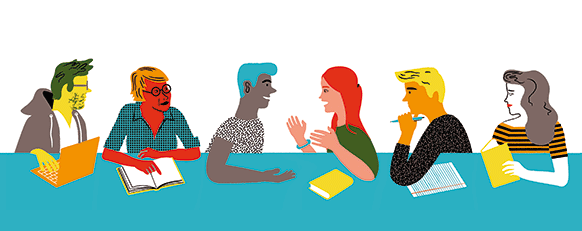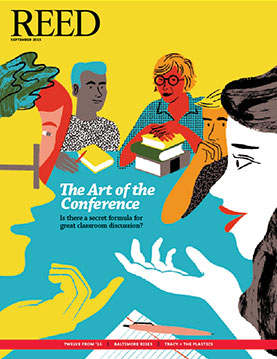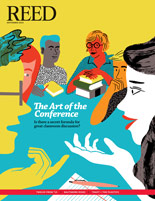
IRIS login | Reed College home Volume 94, No. 3: September 2015
The Art of the Conference

Illustration for Reed Magazine by Golden Cosmos
Is there a secret formula for great classroom discussion?
What is the secret (or not-so-secret) formula for a great Reed conference? We asked seven professors representing all five academic divisions to share their insights on this subject—one of the most important, but also most elusive, aspects of a Reed education.
Introduction
By Prof. Kathryn Oleson [psychology 1995–]

As you read through their responses, you’ll see that preparation and imagination are fundamental. Professors must select challenging course readings, devise an adaptable plan to guide classroom discussion, forge a sense of community, and prepare themselves to take risks. But it’s not enough for students just to show up—their preparation, commitment, and engagement are equally vital. Indeed, when professors inspire students to share the responsibility for class together, we experience that Reed moment—communal ownership of learning. The hard work of education becomes the joy of discovery.
At Reed’s new Center for Teaching and Learning, we are honored to have become the repository for the college’s collective pedagogical practice and look forward to the student-, staff- and faculty-generated innovations to come. We encourage you to share your observations and hone your teaching and learning skills in affirmation of Reed’s traditions.
![]()
Learning from the Inside Out
By Prof. Jennifer Henderlong Corpus [psychology 2000–]

Students learn best when they’re intrinsically motivated—when they’re guided by curiosity and interest, and given the opportunity to tackle challenges. Intrinsic motivation is powerful because it sustains beyond the walls of the classroom and provides a foundation for learning and life. Nobody at Reed needs to be convinced of this.
But intrinsic motivation is a fragile virtue, even for Reedies. Research shows that students can only maintain intrinsic motivation when their needs for autonomy, competence, and relatedness are met. A great conference, then, is one that supports these psychological needs. So what does that look like?
Autonomy is supported when students see value in what they’re learning. How this is accomplished certainly varies by discipline, but in my field of developmental psychology we often consider how theory and research inform practice. For example, my students consider how socialization research guides the production of Sesame Street, how motivation research makes a case against high-stakes testing, and how developmental theories shed light on service-learning experiences. Of course, autonomy support is inherent to the conference method itself. When students take responsibility for their own learning through active discussion and debate, they become co-creators of knowledge. This sense of ownership is critical for fostering intrinsic motivation.
Competence flourishes when learning is structured, perhaps ironically even in a student-centered conference setting. This often means opening each conference with a few minutes of contextualizing commentary, followed by an “invisible” lesson plan of prompts and observations that guide students toward essential themes. Conference can also be structured through preparatory activities: In introductory psychology, for example, students complete written questions before conference that require them to extract design elements and interpret numerical data from each primary source reading. This type of scaffolding not only provides tools for understanding but also sends the important message that competence itself can grow.
Relatedness is supported when students feel security and connectedness in their learning environments. In my experience, this requires ongoing dialogue about active listening, openness to differences, and the learning that comes from articulating our ideas to others. It involves referring to students by name, and encouraging them to talk to each other and build on one another’s contributions. It requires making space for all voices to enter the conversation. Research shows clearly that emotionally supportive classrooms promote well-being, intrinsic motivation, and achievement. We are drawn toward connection with others, and a great conference recognizes this aspect of our humanity.


LATEST COMMENTS
steve-jobs-1976 I knew Steve Jobs when he was on the second floor of Quincy. (Fall...
Utnapishtim - 2 weeks ago
Prof. Mason Drukman [political science 1964–70] This is gold, pure gold. God bless, Prof. Drukman.
puredog - 1 month ago
virginia-davis-1965 Such a good friend & compatriot in the day of Satyricon...
czarchasm - 4 months ago
John Peara Baba 1990 John died of a broken heart from losing his mom and then his...
kodachrome - 7 months ago
Carol Sawyer 1962 Who wrote this obit? I'm writing something about Carol Sawyer...
MsLaurie Pepper - 8 months ago
William W. Wissman MAT 1969 ...and THREE sisters. Sabra, the oldest, Mary, the middle, and...
riclf - 10 months ago